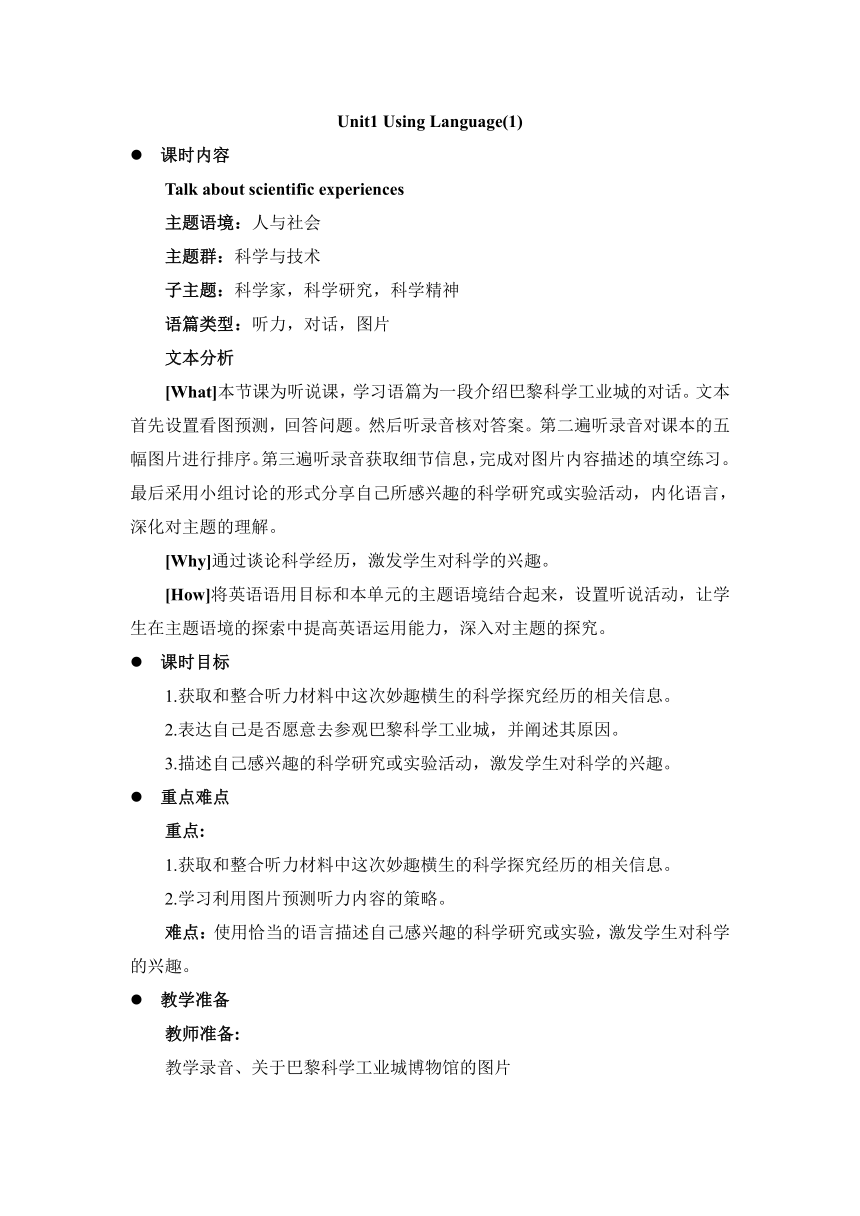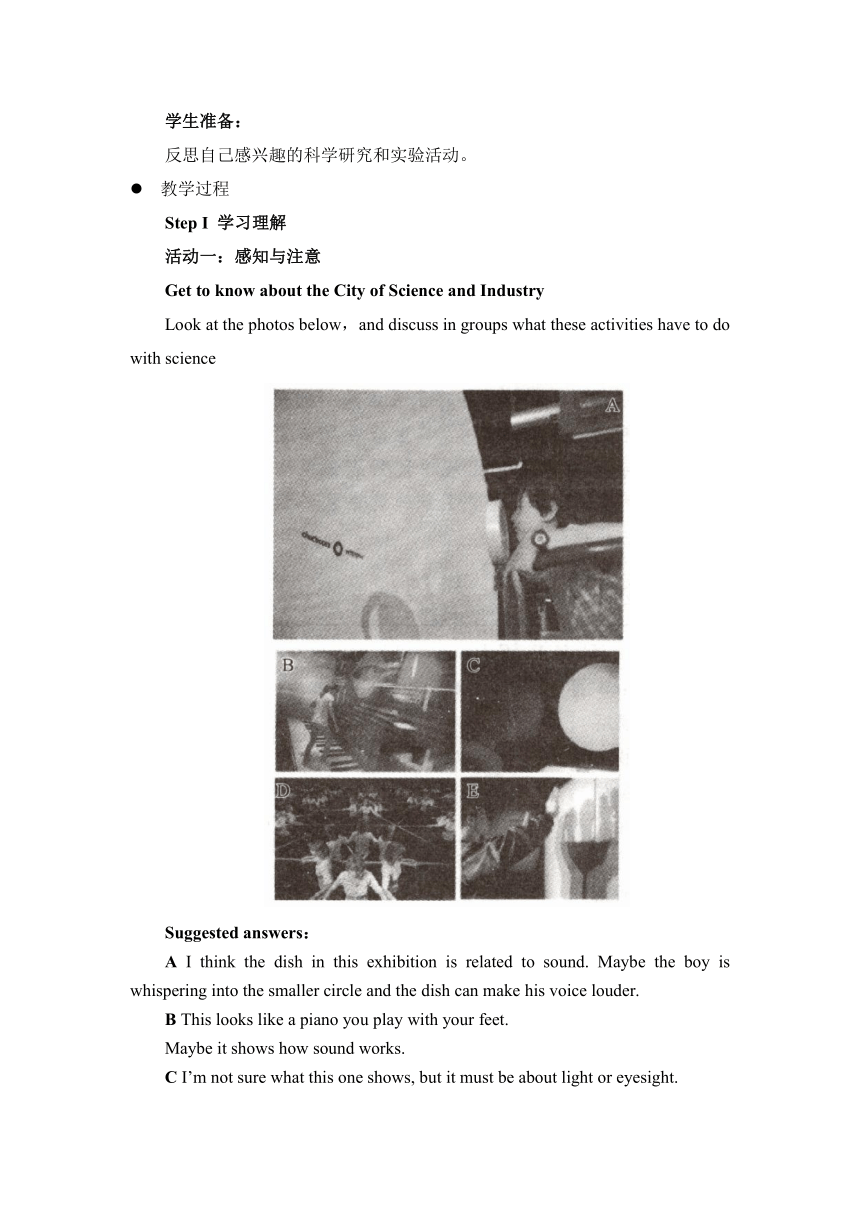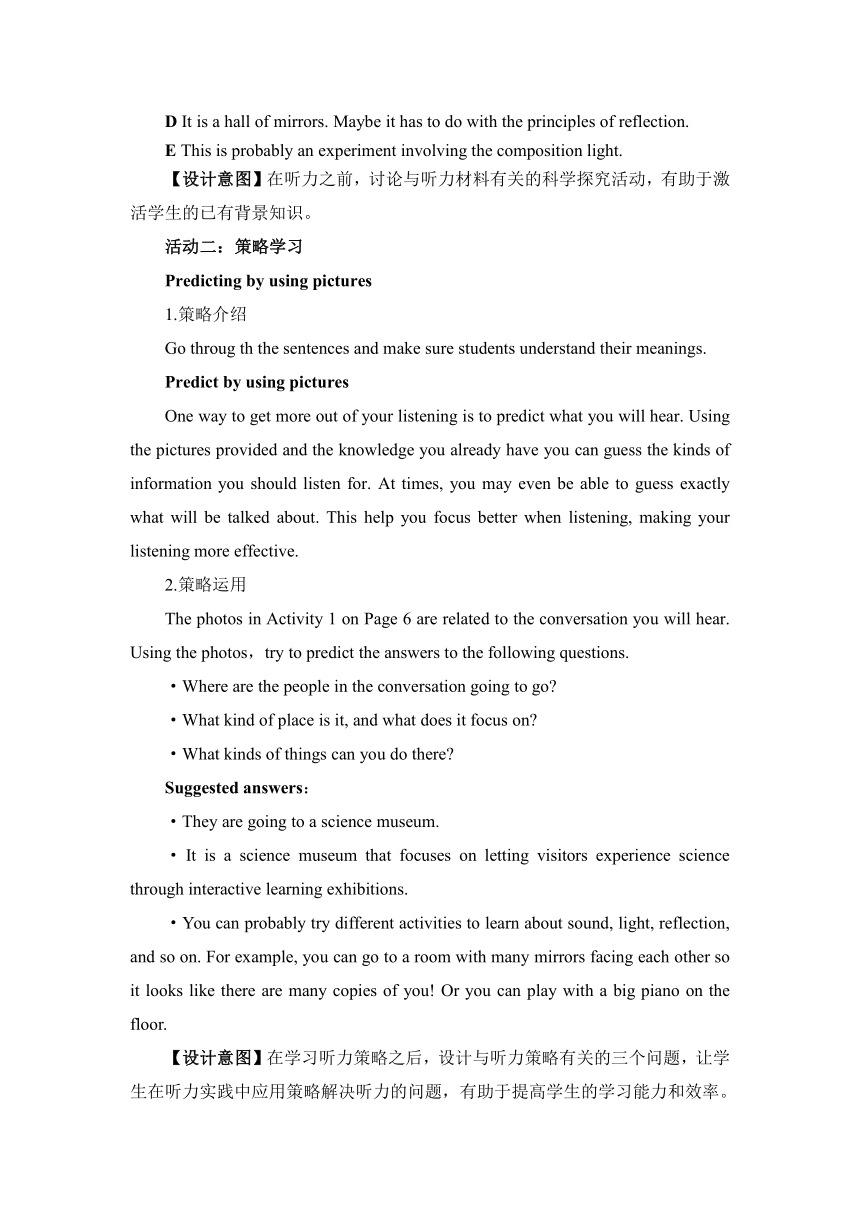人教版(2019)高中英语选择性必修第二册 Unit1Science and Scientists Using Language(1) 名师教学设计
文档属性
| 名称 | 人教版(2019)高中英语选择性必修第二册 Unit1Science and Scientists Using Language(1) 名师教学设计 |  | |
| 格式 | docx | ||
| 文件大小 | 712.9KB | ||
| 资源类型 | 教案 | ||
| 版本资源 | 人教版(2019) | ||
| 科目 | 英语 | ||
| 更新时间 | 2023-03-12 12:31:44 | ||
图片预览



文档简介
Unit1 Using Language(1)
课时内容
Talk about scientific experiences
主题语境:人与社会
主题群:科学与技术
子主题:科学家,科学研究,科学精神
语篇类型:听力,对话,图片
文本分析
[What]本节课为听说课,学习语篇为一段介绍巴黎科学工业城的对话。文本首先设置看图预测,回答问题。然后听录音核对答案。第二遍听录音对课本的五幅图片进行排序。第三遍听录音获取细节信息,完成对图片内容描述的填空练习。最后采用小组讨论的形式分享自己所感兴趣的科学研究或实验活动,内化语言,深化对主题的理解。
[Why]通过谈论科学经历,激发学生对科学的兴趣。
[How]将英语语用目标和本单元的主题语境结合起来,设置听说活动,让学生在主题语境的探索中提高英语运用能力,深入对主题的探究。
课时目标
1.获取和整合听力材料中这次妙趣横生的科学探究经历的相关信息。
2.表达自己是否愿意去参观巴黎科学工业城,并阐述其原因。
3.描述自己感兴趣的科学研究或实验活动,激发学生对科学的兴趣。
重点难点
重点:
1.获取和整合听力材料中这次妙趣横生的科学探究经历的相关信息。
2.学习利用图片预测听力内容的策略。
难点:使用恰当的语言描述自己感兴趣的科学研究或实验,激发学生对科学的兴趣。
教学准备
教师准备:
教学录音、关于巴黎科学工业城博物馆的图片
学生准备:
反思自己感兴趣的科学研究和实验活动。
教学过程
Step I 学习理解
活动一:感知与注意
Get to know about the City of Science and Industry
Look at the photos below,and discuss in groups what these activities have to do with science
Suggested answers:
A I think the dish in this exhibition is related to sound. Maybe the boy is whispering into the smaller circle and the dish can make his voice louder.
B This looks like a piano you play with your feet.
Maybe it shows how sound works.
C I’m not sure what this one shows, but it must be about light or eyesight.
D It is a hall of mirrors. Maybe it has to do with the principles of reflection.
E This is probably an experiment involving the composition light.
【设计意图】在听力之前,讨论与听力材料有关的科学探究活动,有助于激活学生的已有背景知识。
活动二:策略学习
Predicting by using pictures
1.策略介绍
Go throug th the sentences and make sure students understand their meanings.
Predict by using pictures
One way to get more out of your listening is to predict what you will hear. Using the pictures provided and the knowledge you already have you can guess the kinds of information you should listen for. At times, you may even be able to guess exactly what will be talked about. This help you focus better when listening, making your listening more effective.
2.策略运用
The photos in Activity 1 on Page 6 are related to the conversation you will hear. Using the photos,try to predict the answers to the following questions.
·Where are the people in the conversation going to go
·What kind of place is it, and what does it focus on
·What kinds of things can you do there
Suggested answers:
·They are going to a science museum.
·It is a science museum that focuses on letting visitors experience science through interactive learning exhibitions.
·You can probably try different activities to learn about sound, light, reflection, and so on. For example, you can go to a room with many mirrors facing each other so it looks like there are many copies of you! Or you can play with a big piano on the floor.
【设计意图】在学习听力策略之后,设计与听力策略有关的三个问题,让学生在听力实践中应用策略解决听力的问题,有助于提高学生的学习能力和效率。
活动三:获取与梳理
1.Listen and match
Listen to the conversation and see if your answers for Activity 2 are correct. Then write down the letters(A-E)for the photos in the order that you hear them described.
Suggested answers:
1D 2C 3E 4B 5A
2. Listen and fill
Listen again and complete the descriptions of the photos above.
Photo A: A giant dish; when you speak into it, it ________ the sound back and ________. You can use it to speak in a ________ to someone 17 metres away. Photo B: A giant ________ that you can use your feet to play. Instead of playing the sounds of a piano it plays the voices of ________. Photo C: You look at a blue screen for a while, and then suddenly you can see ________ moving around on it. These are our ________. Photo D: A ________ where you can see yourself reflected thousands of times Photo E: You stand in front of ________, and it casts different shadows of you, in ________ the rainbow.
Suggested answers:
A reflects; makes it louder; whisper
B piano keyboard; classical singers
C tiny bright lights; own blood cells
D hall of mirrors
E a white light; every colour of
【设计意图】播放两次录音,第一次听验证预测是否正确并给五张图片排序;第二次听获取五张图片的细节内容。通过这个活动,学生学习和运用预测学习策略,获取和整合五张图片的细节内容,更重要的是获取科学实验的相关经验,有助于加深对单元主题意义的理解,也有利于口语活动的开展。
Step Ⅱ 应用实践
活动四:分析与判断
Discuss the following questions in groups.
·The conversation is about the City of Science and Industry,a museum in Paris. Would you like to go to this museum?Why or why not?
·Are there any museums like this in China?What other interesting museums are there?
Suggested answers:
·Yes. The exhibitions seem really interesting. I think I would learn a lot there.
·Yes. For example, there is the China Science and Technology Museum in Beijing and the Shanghai Science and Technology Museum.
【设计意图】在获取巴黎科学工业城的相关信息后,学生表达自己是否愿意去参观巴黎科学工业城,并阐述其原因。接着展开想象,国内是否有类似的博物馆。这个过程有利于实现语言知识的内化,提高学生的语言表达能力,深化对主题的认识。
活动五:描述与阐释
Talk about another scientific research or experiment
1.Learn language.
(1)Ask students to read the following structures.
Talking about scientific phenomena …can/cannot exist in the form of a solid/gas and a liquid/plasma… …is both a… and a... at the same time… how light/sound is reflected… …the existence of other… This occurs when… If you..., it will become… That demonstrates… This experiment/research shows… Through this, we know that… We can prove that… This evidence proves…
(2) Ask students to read the above structures over and over again until they can speak fluently
2. Choose a topic.
In groups, choose one of the museum activities on Page 6 or brainstorm another scientific research or experiment that they are interested in.
3. Make a short presentation
(1) Read the example.
Example Today, I want to talk to you about a very strange phenomenon called a non-Newtonian fluid. You can make it easily using equal parts of water and cornflour, like I have here. A non-Newtonian fluid is strange because you can pour it like a liquid, but if you put any pressure on it suddenly becomes hard as concrete. In fact, it becomes hard enough to stand on. Then, as soon as you take the pressure off, it becomes a liquid again. This shows that it is possible that something can exist as a liquid and a solid at the same time.
(2)Make a short presentation to the class about your choice. Use the example and useful phrases above to help you.
【设计意图】在口语输出之前,教师给学生提供一些描述科学研究或实验活动的过渡句型。学生通过阅读,获取这些信息,为口语活动提供背景常识和语言结构,使得有话可说。
Step Ⅲ 迁移创新
活动六:想象与创造
Write about your own scientific research or experiences
1.Ask students to write about their own interesting Scientific research or experiences.
2.Share their writings in groups.
【设计意图】在英语课堂教学中,设定特定的场景,让学生结合自己的经验去描述和阐述自己的科学实验和科学经历,使学生们在轻松愉快的环境中学习,激发出学生主动学习的愿望,发展学生的语言运用能力,培养学生对科学的兴趣。
板书设计
Unit 1 Science and Scientists Period w Using Language(1) I.学习理解 活动一:感知与注意 Get to know about the City of Science and Industry 活动二:策略学习 Predicting by using pictures 活动三:获取与梳理 1.Listen and match 2.Listen and fill Ⅱ.应用实践 活动四:分析与判断 活动五:描述与阐释 Talk about another scientific research or experiment 1.Learn language. 2.Choose a topic. 3.Make a short presentation. Ⅲ.迁移创新 活动六:想象与创造 Write about your own scientific research or experiences
课时内容
Talk about scientific experiences
主题语境:人与社会
主题群:科学与技术
子主题:科学家,科学研究,科学精神
语篇类型:听力,对话,图片
文本分析
[What]本节课为听说课,学习语篇为一段介绍巴黎科学工业城的对话。文本首先设置看图预测,回答问题。然后听录音核对答案。第二遍听录音对课本的五幅图片进行排序。第三遍听录音获取细节信息,完成对图片内容描述的填空练习。最后采用小组讨论的形式分享自己所感兴趣的科学研究或实验活动,内化语言,深化对主题的理解。
[Why]通过谈论科学经历,激发学生对科学的兴趣。
[How]将英语语用目标和本单元的主题语境结合起来,设置听说活动,让学生在主题语境的探索中提高英语运用能力,深入对主题的探究。
课时目标
1.获取和整合听力材料中这次妙趣横生的科学探究经历的相关信息。
2.表达自己是否愿意去参观巴黎科学工业城,并阐述其原因。
3.描述自己感兴趣的科学研究或实验活动,激发学生对科学的兴趣。
重点难点
重点:
1.获取和整合听力材料中这次妙趣横生的科学探究经历的相关信息。
2.学习利用图片预测听力内容的策略。
难点:使用恰当的语言描述自己感兴趣的科学研究或实验,激发学生对科学的兴趣。
教学准备
教师准备:
教学录音、关于巴黎科学工业城博物馆的图片
学生准备:
反思自己感兴趣的科学研究和实验活动。
教学过程
Step I 学习理解
活动一:感知与注意
Get to know about the City of Science and Industry
Look at the photos below,and discuss in groups what these activities have to do with science
Suggested answers:
A I think the dish in this exhibition is related to sound. Maybe the boy is whispering into the smaller circle and the dish can make his voice louder.
B This looks like a piano you play with your feet.
Maybe it shows how sound works.
C I’m not sure what this one shows, but it must be about light or eyesight.
D It is a hall of mirrors. Maybe it has to do with the principles of reflection.
E This is probably an experiment involving the composition light.
【设计意图】在听力之前,讨论与听力材料有关的科学探究活动,有助于激活学生的已有背景知识。
活动二:策略学习
Predicting by using pictures
1.策略介绍
Go throug th the sentences and make sure students understand their meanings.
Predict by using pictures
One way to get more out of your listening is to predict what you will hear. Using the pictures provided and the knowledge you already have you can guess the kinds of information you should listen for. At times, you may even be able to guess exactly what will be talked about. This help you focus better when listening, making your listening more effective.
2.策略运用
The photos in Activity 1 on Page 6 are related to the conversation you will hear. Using the photos,try to predict the answers to the following questions.
·Where are the people in the conversation going to go
·What kind of place is it, and what does it focus on
·What kinds of things can you do there
Suggested answers:
·They are going to a science museum.
·It is a science museum that focuses on letting visitors experience science through interactive learning exhibitions.
·You can probably try different activities to learn about sound, light, reflection, and so on. For example, you can go to a room with many mirrors facing each other so it looks like there are many copies of you! Or you can play with a big piano on the floor.
【设计意图】在学习听力策略之后,设计与听力策略有关的三个问题,让学生在听力实践中应用策略解决听力的问题,有助于提高学生的学习能力和效率。
活动三:获取与梳理
1.Listen and match
Listen to the conversation and see if your answers for Activity 2 are correct. Then write down the letters(A-E)for the photos in the order that you hear them described.
Suggested answers:
1D 2C 3E 4B 5A
2. Listen and fill
Listen again and complete the descriptions of the photos above.
Photo A: A giant dish; when you speak into it, it ________ the sound back and ________. You can use it to speak in a ________ to someone 17 metres away. Photo B: A giant ________ that you can use your feet to play. Instead of playing the sounds of a piano it plays the voices of ________. Photo C: You look at a blue screen for a while, and then suddenly you can see ________ moving around on it. These are our ________. Photo D: A ________ where you can see yourself reflected thousands of times Photo E: You stand in front of ________, and it casts different shadows of you, in ________ the rainbow.
Suggested answers:
A reflects; makes it louder; whisper
B piano keyboard; classical singers
C tiny bright lights; own blood cells
D hall of mirrors
E a white light; every colour of
【设计意图】播放两次录音,第一次听验证预测是否正确并给五张图片排序;第二次听获取五张图片的细节内容。通过这个活动,学生学习和运用预测学习策略,获取和整合五张图片的细节内容,更重要的是获取科学实验的相关经验,有助于加深对单元主题意义的理解,也有利于口语活动的开展。
Step Ⅱ 应用实践
活动四:分析与判断
Discuss the following questions in groups.
·The conversation is about the City of Science and Industry,a museum in Paris. Would you like to go to this museum?Why or why not?
·Are there any museums like this in China?What other interesting museums are there?
Suggested answers:
·Yes. The exhibitions seem really interesting. I think I would learn a lot there.
·Yes. For example, there is the China Science and Technology Museum in Beijing and the Shanghai Science and Technology Museum.
【设计意图】在获取巴黎科学工业城的相关信息后,学生表达自己是否愿意去参观巴黎科学工业城,并阐述其原因。接着展开想象,国内是否有类似的博物馆。这个过程有利于实现语言知识的内化,提高学生的语言表达能力,深化对主题的认识。
活动五:描述与阐释
Talk about another scientific research or experiment
1.Learn language.
(1)Ask students to read the following structures.
Talking about scientific phenomena …can/cannot exist in the form of a solid/gas and a liquid/plasma… …is both a… and a... at the same time… how light/sound is reflected… …the existence of other… This occurs when… If you..., it will become… That demonstrates… This experiment/research shows… Through this, we know that… We can prove that… This evidence proves…
(2) Ask students to read the above structures over and over again until they can speak fluently
2. Choose a topic.
In groups, choose one of the museum activities on Page 6 or brainstorm another scientific research or experiment that they are interested in.
3. Make a short presentation
(1) Read the example.
Example Today, I want to talk to you about a very strange phenomenon called a non-Newtonian fluid. You can make it easily using equal parts of water and cornflour, like I have here. A non-Newtonian fluid is strange because you can pour it like a liquid, but if you put any pressure on it suddenly becomes hard as concrete. In fact, it becomes hard enough to stand on. Then, as soon as you take the pressure off, it becomes a liquid again. This shows that it is possible that something can exist as a liquid and a solid at the same time.
(2)Make a short presentation to the class about your choice. Use the example and useful phrases above to help you.
【设计意图】在口语输出之前,教师给学生提供一些描述科学研究或实验活动的过渡句型。学生通过阅读,获取这些信息,为口语活动提供背景常识和语言结构,使得有话可说。
Step Ⅲ 迁移创新
活动六:想象与创造
Write about your own scientific research or experiences
1.Ask students to write about their own interesting Scientific research or experiences.
2.Share their writings in groups.
【设计意图】在英语课堂教学中,设定特定的场景,让学生结合自己的经验去描述和阐述自己的科学实验和科学经历,使学生们在轻松愉快的环境中学习,激发出学生主动学习的愿望,发展学生的语言运用能力,培养学生对科学的兴趣。
板书设计
Unit 1 Science and Scientists Period w Using Language(1) I.学习理解 活动一:感知与注意 Get to know about the City of Science and Industry 活动二:策略学习 Predicting by using pictures 活动三:获取与梳理 1.Listen and match 2.Listen and fill Ⅱ.应用实践 活动四:分析与判断 活动五:描述与阐释 Talk about another scientific research or experiment 1.Learn language. 2.Choose a topic. 3.Make a short presentation. Ⅲ.迁移创新 活动六:想象与创造 Write about your own scientific research or experiences
